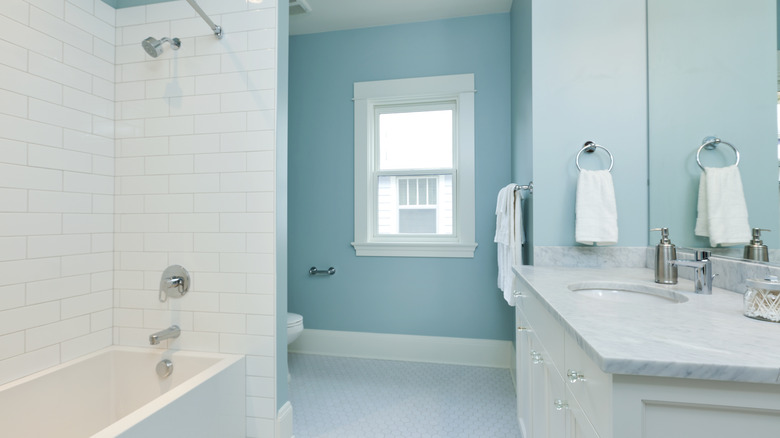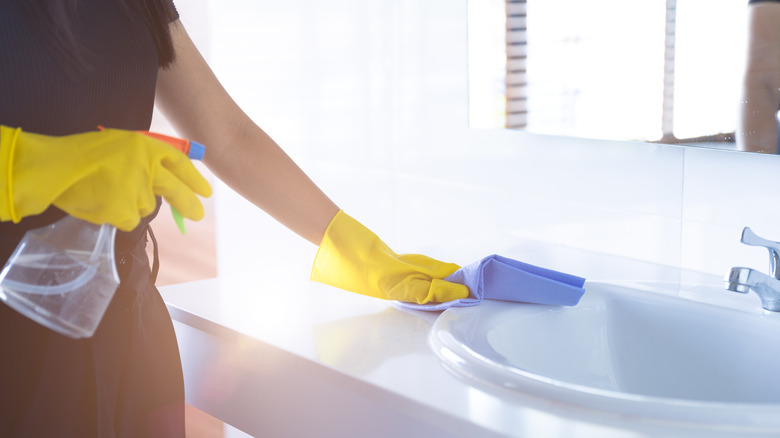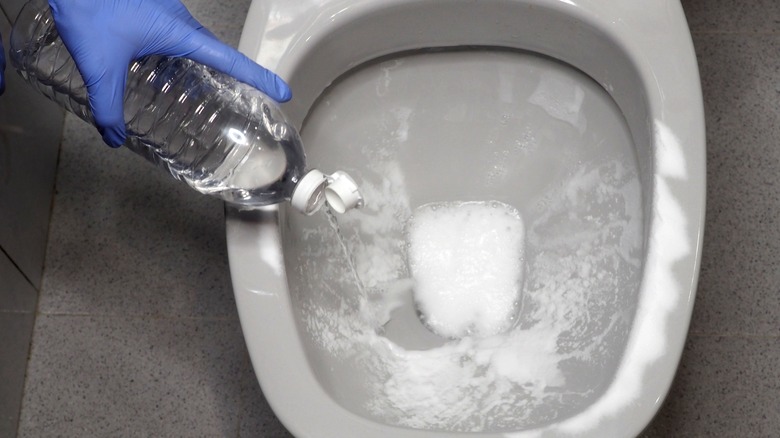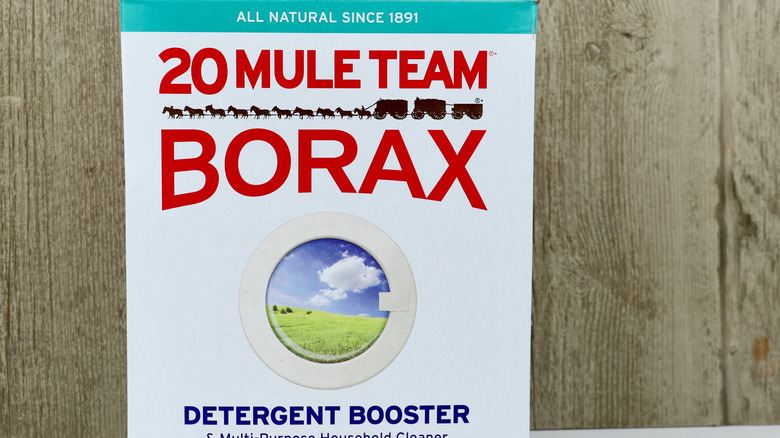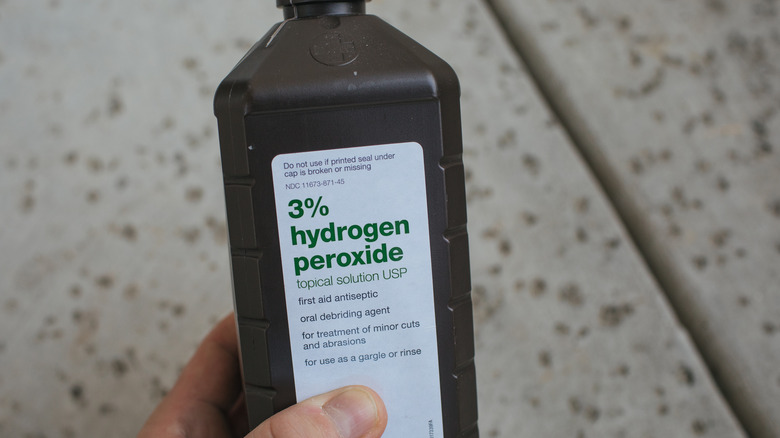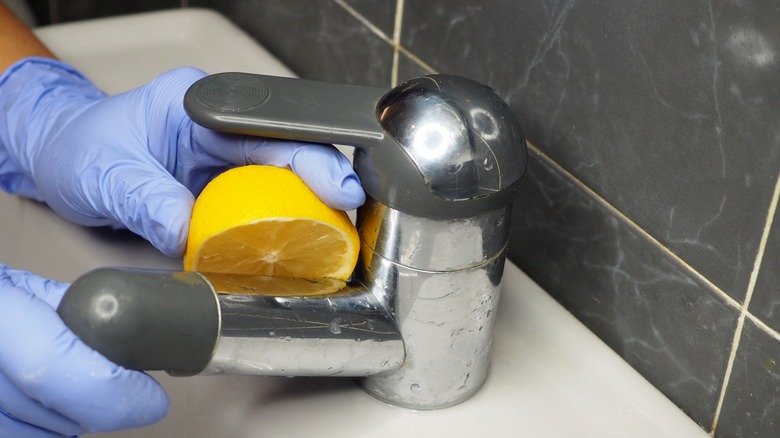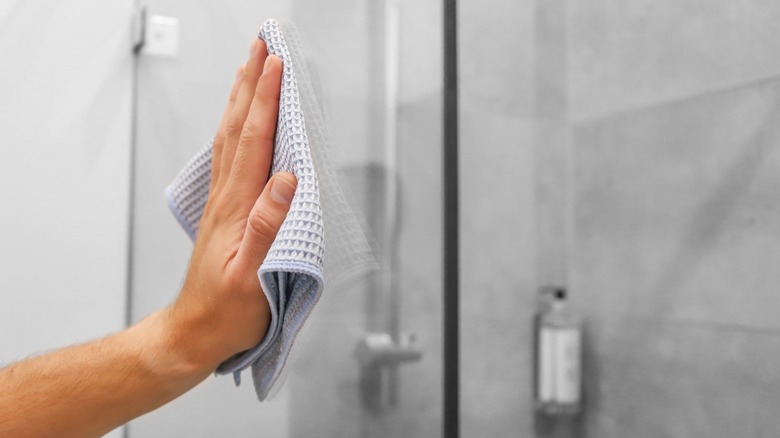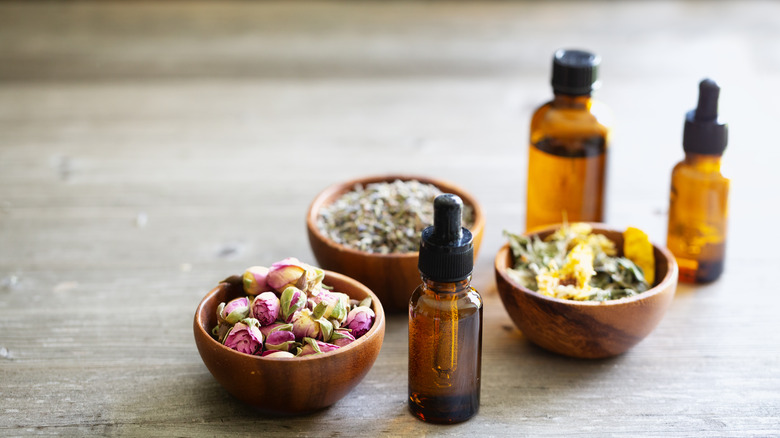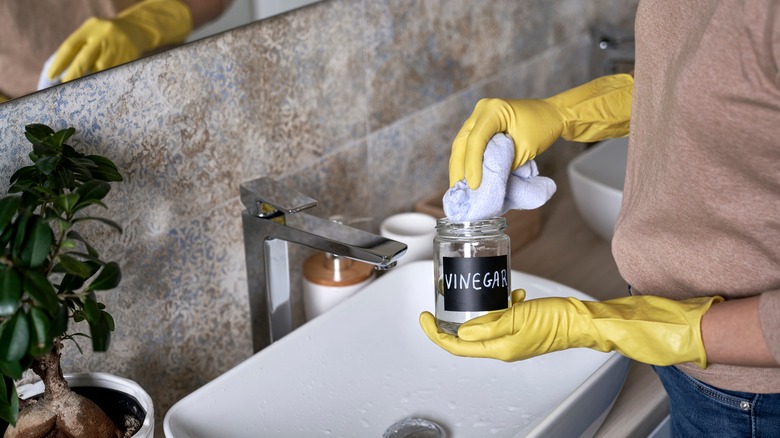Natural Ingredients That Will Leave Your Bathroom Dazzling Clean
Cleaning the bathroom is nobody's idea of fun, but we all have to do it. Using natural ingredients to clean the multiple surfaces in your bathroom, you can achieve pristine results while also ensuring a healthy environment for yourself and your family. So, it makes sense to opt for safe, natural, and effective cleaning agents to get this dirty job done.
Many commercial cleaners contain chemicals that are harmful to humans, pets, and the environment. But when you choose natural ingredients on cleaning day, you're making your home a better place while contributing to a greener planet. With a few inexpensive household substances like vinegar, baking soda, and hydrogen peroxide, you can avoid using chlorine bleach and other harsh chemicals. But be aware that even some natural substances may be harmful if used in the wrong ways. Learn about natural cleaning ingredients, along with warnings for using them safely in cleaning your bathroom, if you want to go the DIY route.
Vinegar contains acetic acid as a natural cleaning agent
Both white and apple cider vinegars work well as natural bathroom cleaners due to their acetic acid content that breaks down dirt. The vinegar that is widely available to the public is composed of 4 to 6% acetic acid diluted in water. White vinegar is a stronger cleaning agent because it contains slightly more acetic acid than apple cider vinegar, but the trade-off is a more pungent odor. However, the odor dissipates once you rinse and dry the cleaned surfaces. A 2020 study in the journal BMC Microbiology notes that the amount of acetic acid found in vinegar is not enough to make it a disinfectant. However, it is effective on some germs like E. Coli and Salmonella bacteria, per Healthline.
Mix equal parts vinegar and water to clean your bathroom surfaces. Use a sponge or microfiber cloth to wipe away mildew and soap scum. Clean your toilet by pouring in ½ cup of vinegar and letting it sit for 15 minutes before scrubbing and flushing. Additionally, you can unclog your bathroom drain with ½ cup of baking soda followed by one cup of vinegar. Spray white vinegar on shower doors, walls and shower curtains to fight mildew.
The Environmental Protection Agency warns that you should never mix vinegar with bleach; it will create a toxic gas that is harmful to humans. Due to the acetic acid content, it's best to avoid cleaning natural stone countertops with vinegar. Additionally, you should use vinegar sparingly or not at all on grouted tile surfaces, as the acetic acid will eat away the grout over time.
Baking soda is a mild alkali with gentle abrasive qualities
The white powder commonly known as baking soda is a naturally occurring substance called sodium bicarbonate (NaHCO3). It's effective for multiple cleaning tasks, and it's non-toxic around children and pets. When it comes in contact with grease and dirt, the mild alkali content in baking soda causes the grime to dissolve in water. Alternatively, the undissolved powder acts as a mild abrasive when you use baking soda on a sponge to gently scour dirty surfaces. In addition to its cleaning abilities, baking soda acts as a deodorizing agent. The substance neutralizes odors through a chemical reaction that brings basic and acidic odor molecules into a neutral state. So, your bathroom not only looks clean, it also smells fresh.
To make an all-purpose cleaning solution, dissolve 4 tablespoons of baking soda in a quart of warm water. You can use this mixture on a cloth or sponge to wipe sinks, tubs, and countertops. It's equally effective for mopping the bathroom floor. To clean your toilet, pour in 1 cup of baking soda and follow it with 1 cup of vinegar. Let the fizzy substance sit in the bowl for 30 minutes before scrubbing and flushing. Baking soda will not harm fiberglass, porcelain, ceramic tile, acrylic, and cultured marble surfaces. However, it's best to avoid using baking soda for cleaning glass shower doors and bathroom mirrors. The mildly abrasive substance may scratch the glass. Additionally, you should not use baking soda to clean wood and stone resin materials.
Borax is a natural cleaner for bathroom fixtures
Borax is a cleaner that's been in use for more than 100 years. The active ingredient is sodium borate decahydrate, a naturally occurring mineral. This cleaning agent takes the form of a mildly abrasive white powder. Borax softens hard water to remove mineral buildup, and it acts as a deodorizing agent. In addition to working as a cleaner for sinks, tubs, toilets, and countertops, borax also fights mold and mildew in humid bathroom environments by preventing the fungal spores from reproducing.
To make a multi-purpose cleaner for bathroom surfaces, you can dissolve ½ cup of borax in 12 ounces of warm water. Mix it in a 12-to-16 ounce spray bottle until the powder is completely dissolved. Spray the mixture on bathroom surfaces and wipe with a soft cloth.
However, exercise caution when you use borax to clean your bathroom. It can cause irritation to the eyes and skin. Keep the area well ventilated, and wear gloves that protect your hands and arms, as well as eye protection. Try not to inhale the borax powder. Be sure to keep it away from children and pets, as borax is toxic for little ones, even in tiny amounts.
Hydrogen peroxide disinfects and removes stains
Hydrogen peroxide is a natural substance that not only kills viruses, fungi, and bacteria but also bleaches surfaces. The molecular formula is H2O2, so it's basically water with one extra atom of oxygen. The hydrogen peroxide liquid that we find in the familiar brown plastic bottle is a diluted form composed of 3% hydrogen peroxide and 97% water. This is the type recommended for cleaning and disinfecting bathroom surfaces.
It's okay to use hydrogen peroxide at full strength on a sponge or cloth to wipe down your bathroom fixtures and surfaces. Alternatively, you can make a spray cleaner with 1 cup of hydrogen peroxide, 2 cups of distilled water, and 2 tablespoons of lemon juice. Pour the ingredients into a solid-colored spray bottle and shake well. Hydrogen peroxide should not be exposed to light, so it's best to store the cleaner in a dark place. Porcelain sinks, tubs, and toilets benefit from cleaning with hydrogen peroxide, as the liquid does not scratch the surfaces in the way that abrasive powders do. Spray or pour it on the porcelain to remove stains. Due to its bleaching capabilities, you'll want to be careful not to spill hydrogen peroxide on towels, rugs, or other fabrics in the bathroom.
Citric acid dissolves dirt and grime naturally
Plant-based cleaning agents are considered to be greener than those with strong chemicals. Citric acid is a naturally occurring substance found in citrus fruits like lemons, oranges, and grapefruits. It's an antibacterial agent that is non-toxic to humans. Citric acid is useful in the bathroom because it dissolves soap scum and breaks down the mineral deposits from hard water. On top of that, it removes stains and kills germs. With those capabilities, citric acid not only makes your bathroom look clean, it also ensures a healthier environment for your family.
You may find citric acid as the natural cleaning agent in some commercially prepared cleaners. But for a more organic source, you can simply use lemon juice. Full strength lemon juice removes toilet bowl stains if you pour it in and allow it to sit for a few hours or overnight. Alternatively, you might purchase a bag of powdered citric acid and mix the powder with water. The mixture should be 5 to 7% citric acid powder diluted with 93 to 95% warm water. Use it with a bucket and sponge, or pour the solution into a spray bottle for multi-surface bathroom cleaning. Lemon juice and diluted citric acid are safe to use on porcelain sinks, tubs, and most hard surfaces. However, repeated use may produce micro-pitting results on porous stone like marble and granite as well as stainless steel surfaces. Additionally, citric acid may eat away the grout between tiles over time.
Household ammonia is a natural glass cleaner
Pure ammonia is a natural gas that is commonly found in nature. Dissolved in water, it becomes ammonium hydroxide. The liquid that we commonly call household ammonia is a diluted solution composed of 5 to 10% ammonium hydroxide with 90 to 95% water. Household ammonia effectively removes stains and breaks down grime, oils, and grease. In the bathroom, it removes hard water buildup and acts as an antimicrobial agent to kill bacteria.
Ammonia is an effective cleaner for tubs, sinks, toilets, tiles, and countertops in the bathroom. Due to its tendency to evaporate rapidly, ammonia does not leave streaks when it's used to clean mirrors and other glass surfaces. For cleaning the bathroom, use 1 cup of household ammonia diluted in 1 gallon of hot water. Mix the solution in a bucket, and use a sponge or cloth to wipe bathroom surfaces. Alternatively, you can pour the solution into a spray bottle and spray it on soap scum and hard water buildup. Let it sit for 30 minutes before rinsing and drying the surfaces.
Due to its toxicity, you should be cautious when you clean with household ammonia. It's best to avoid using it in bathrooms where children and pets will touch the counters and floors. Ventilate the area thoroughly, as the fumes are sharp and irritating. Wear gloves and goggles to avoid ammonia coming into contact with your eyes and skin. Never mix ammonia with chlorine bleach, as it creates a highly toxic gas.
Add essential oils to cleaning solutions to make your bathroom smell amazing
While you're cleaning your bathroom with natural ingredients to make it fresh and hygienic, why not add essential oils that will make it smell wonderful, too? These fragrance-producing compounds are extracted from the flowers, bark, and leaves of plants via steaming or pressing. Many people use essential oils for aromatherapy that contributes to their wellbeing and elevates their moods. In addition to their pleasant aromas, some essential oils demonstrate antimicrobial capabilities to fight bacteria and viruses in the bathroom. A 2019 paper in the journal Molecules found that certain essential oils (such as lavender, thyme, peppermint, cajuput, cinnamon, clove, eucalyptus, sage, and tea tree) have varying degrees of antibacterial and anti-fungal activity to make your bathroom a healthier place.
The best practices for incorporating essential oils into your bathroom-cleaning regimen involve diluting the oils in solutions with other natural cleaning substances. For example, you can make a spray cleaner by mixing 2 cups white vinegar with 3 drops lavender oil and 2 drops bergamot oil. For a different DIY spray cleaner, you can mix ¼ cup vinegar with 1 teaspoon castile soap and 12 to 20 drops essential oil dissolved in 2 cups of boiled or distilled water. If you shop for essential oils, be sure to choose those that are labeled organic and 100% pure. Avoid scented oils, and do not ingest essential oils. Always use essential oils in diluted solutions, and be aware that some may be toxic for pets.
Try these recipes for natural, homemade bathroom cleaners
Natural ingredients work well when they're combined in specific recipes to make DIY cleaning products for your bathroom. The ingredients are inexpensive, and the recipes are easy to follow. Some are effective for specific cleaning problems, like cutting through soap scum or removing hard water stains from porcelain. Others are general cleaners for multiple bathroom surfaces.
To make an all-purpose cleaning spray, combine 1 cup distilled water with 1 cup white vinegar, ½ cup lemon juice, and 15 drops of essential oil in a spray bottle. Shake well to mix the ingredients. You can make a toilet bowl cleaner with ¼ cup white vinegar and ¼ cup baking soda. After these ingredients stop fizzing, add 30 drops of peppermint essential oil and pour the mixture into the toilet. Then, scrub and flush. If hard water stains are a problem, you can increase the amounts to 2 cups vinegar and 1 cup baking soda. Then, let the mixture sit in the toilet for 30 minutes before scrubbing and flushing. To remove hard water deposits and soap scum from shower doors and chrome fixtures, mix a solution of ½ cup vinegar with ½ cup baking soda and 1 gallon of water. Alternatively, you might mix ½ cup ammonia with ⅓ cup vinegar and ¼ cup baking soda in 1 gallon of water. Use one of these solutions in a bucket with a sponge, or pour it into a spray bottle to wipe down countertops, sinks, tubs, and other bathroom surfaces. Use vinegar and other acidic ingredients sparingly on grout, as it eats away the grout with repeated use.
These commercial cleaning products contain natural ingredients
When it's time to restock your cleaning supply cupboard, you might opt for commercially prepared cleaners that feature natural ingredients. All-natural, commercial products advertise that they are not only healthy for users but also good for the planet. For example, the origins of Dr. Bronner's castile soap dates back to 1858. Mix ¼ cup of the liquid castile soap with 1 quart of water to make a cleaning spray for the bathroom. Similarly, Bon Ami is a white-powder cleaner that's been around since 1886. Using the mineral feldspar as a natural and mildly abrasive ingredient, Bon Ami cleans without scratching surfaces. The powder will safely clean stainless steel, porcelain, fiberglass, acrylic, and enamel. More modern examples include Humble Suds all-purpose cleaner, made from natural ingredients and essential oils. The toilet bowl cleaning tablets from Blueland (another newcomer to the cleaning community) utilize plant-based ingredients to clean efficiently as they dissolve in the toilet.
Some commercial products for cleaning the bathroom contain natural ingredients and essential oils but might not be classified as 100% natural. For example, most of the ingredients in Method foaming tub and tile cleaner are derived from natural plant or mineral sources. Similarly, Mrs. Meyer's tub and tile cleaner features essential oils along with a cruelty-free formula containing plant-derived ingredients.
